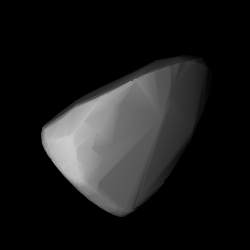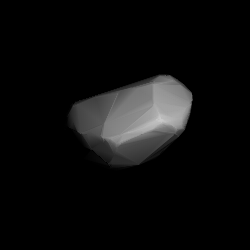Related Research Articles
6433 Enya, provisional designation 1978 WC, is a stony background asteroid from the inner regions of the asteroid belt, approximately 7 kilometers in diameter. It was discovered on 18 November 1978, by Czech astronomer Antonín Mrkos at the Kleť Observatory in the Czech Republic. It was named for Irish musician Enya.

1554 Yugoslavia, provisional designation 1940 RE, is a stony Eunomian asteroid from the middle region of the asteroid belt, approximately 16 kilometres (9.9 mi) in diameter. It was discovered by Serbian astronomer Milorad Protić at Belgrade Astronomical Observatory, Serbia, on 6 September 1940. It was named for the former country of Yugoslavia.
1106 Cydonia, provisional designation 1929 CW, is a Eunomian asteroid from the central regions of the asteroid belt, approximately 13 kilometers in diameter. It was discovered on 5 February 1929, by astronomer Karl Reinmuth at the Heidelberg-Königstuhl State Observatory in Germany. The asteroid was named for the fruit-bearing tree Cydonia (quince). The S-type asteroid has a relatively short rotation period of 2.7 hours.
1113 Katja, provisional designation 1928 QC, is a background asteroid from the outer regions of the asteroid belt, approximately 39 kilometers in diameter. It was discovered by Pelageya Shajn at the Simeiz Observatory in 1928, and named after Ekaterina Iosko, a staff member at the discovering observatory.
12848 Agostino, provisional designation 1997 NK10, is a stony Eunomia asteroid from the central region of the asteroid belt, approximately 5 kilometers in diameter.
4175 Billbaum, provisional designation 1985 GX, is a background asteroid from the central regions of the asteroid belt, approximately 9 kilometers in diameter. It was discovered on 15 April 1985, by American astronomer Edward Bowell at the Anderson Mesa Station of the Lowell Observatory near Flagstaff, Arizona. The uncommon L-type asteroid has a short rotation period of 2.73 hours and was named for American astronomer William A. Baum.
1543 Bourgeois, provisional designation 1941 SJ, is a stony asteroid from the central asteroid belt's background population, approximately 12 kilometers in diameter. It was discovered on 21 September 1941, by astronomer Eugène Delporte at the Royal Observatory of Belgium in Uccle. The asteroid was named after Belgian astronomer Paul Bourgeois.
6296 Cleveland, provisional designation 1988 NC, is a Hungaria asteroid from the innermost regions of the asteroid belt, approximately 3.5 kilometers in diameter. It was discovered on 12 July 1988, by American astronomer Eleanor Helin at the Palomar Observatory in California. The presumed E-type asteroid has a long rotation period of 30.8 hours and possibly an elongated shape. It was named for the city of Cleveland in the U.S. state of Ohio.
2187 La Silla, provisionally designated 1976 UH, is a stony Eunomia asteroid from the middle region of the asteroid belt, approximately 12 kilometers in diameter.

1431 Luanda, provisional designation 1937 OB, is a stony Eunomian asteroid from the central regions of the asteroid belt, approximately 14 kilometers in diameter. It was discovered on 29 July 1937, by South African astronomer Cyril Jackson at the Union Observatory in Johannesburg. The asteroid was named after the city of Luanda.
3844 Lujiaxi, provisional designation 1966 BZ, is a Henan asteroid from the central regions of the asteroid belt, approximately 15 kilometers in diameter. It was discovered on 30 January 1966, by astronomers at the Purple Mountain Observatory in Nanking, China. The asteroid was named after Chinese chemist Lu Jiaxi.

1527 Malmquista, provisional designation 1939 UG, is a stony Florian asteroid from the inner regions of the asteroid belt, approximately 10 kilometers in diameter.
3066 McFadden, provisional designation 1984 EO, is a stony background asteroid from the central regions of the asteroid belt, approximately 15 kilometers in diameter. It was discovered on 1 March 1984, by American astronomer Edward Bowell at the Anderson Mesa Station near Tucson, Arizona. It was named for American planetary scientist Lucy-Ann McFadden. The assumed S-type asteroid has a rotation period of 13.8 hours.
2308 Schilt, provisional designation 1967 JM, is a stony Eunomia asteroid from the asteroid belt, approximately 17 kilometers in diameter. It was discovered on 6 May 1967, by Argentine astronomer Carlos Cesco together with American astronomer Arnold Klemola at the Yale–Columbia Southern Station at Leoncito Astronomical Complex in Argentina.

2384 Schulhof (prov. designation: 1943 EC1) is a mid-sized asteroid and the namesake of the Schulhof family, located in the Eunomian region of the intermediate asteroid belt. It was discovered on 2 March 1943, by French astronomer Marguerite Laugier at Nice Observatory in southeastern France. The asteroid was later named after Hungarian astronomer Lipót Schulhof. The presumed S-type asteroid has a short rotation period of 3.3 hours and measures approximately 12 kilometers (7.5 miles) in diameter.
5692 Shirao, provisional designation 1992 FR, is a stony Eunomia asteroid from the middle region of the asteroid belt, approximately 9 kilometers in diameter. It was discovered on 23 March 1992, by Japanese amateur astronomers Kin Endate and Kazuro Watanabe at Kitami Observatory, Hokkaidō, Japan. The asteroid was later named for Japanese geologist and astrophotographer Motomaro Shirao.
1405 Sibelius, provisional designation 1936 RE, is a stony Florian asteroid from the inner regions of the asteroid belt, approximately 8 kilometers in diameter. It was discovered on 12 September 1936, by Finnish astronomer Yrjö Väisälä at Turku Observatory in Southwest Finland. The asteroid was named after composer Jean Sibelius.
2013 Tucapel, provisional designation 1971 UH4, is an eccentric Florian asteroid from the inner regions of the asteroid belt, approximately 11 kilometers in diameter. It was discovered on 22 October 1971, by the University of Chile's National Astronomical Observatory at Cerro El Roble Astronomical Station. It was named for one of the indigenous Mapuche chiefs.
10645 Brač, provisional designation 1999 ES4, is a stony Eunomia asteroid from the central region of the asteroid belt, approximately 10 kilometers in diameter. It was discovered on 14 March 1999, by Croatian astronomer Korado Korlević at Višnjan Observatory, and named after the Croatian island of Brač.
1947 Iso-Heikkilä, provisional designation 1935 EA, is a carbonaceous Eos asteroid from the outer region of the asteroid belt, approximately 30 kilometers in diameter. It was discovered on 4 March 1935, by Finnish astronomer Yrjö Väisälä at Turku Observatory in Southwest Finland. It was named after the location of the discovering observatory, which is also known as the "Iso-Heikkilä Observatory".
References
- 1 2 3 4 "JPL Small-Body Database Browser: 4358 Lynn (A909 TF)" (2017-06-05 last obs.). Jet Propulsion Laboratory . Retrieved 20 June 2017.
- 1 2 3 Schmadel, Lutz D. (2007). "(4358) Lynn". Dictionary of Minor Planet Names – (4358) Lynn. Springer Berlin Heidelberg. p. 374. doi:10.1007/978-3-540-29925-7_4310. ISBN 978-3-540-00238-3.
- 1 2 3 4 5 6 "LCDB Data for (4358) Lynn". Asteroid Lightcurve Database (LCDB). Retrieved 9 June 2016.
- 1 2 3 4 Masiero, Joseph R.; Mainzer, A. K.; Grav, T.; Bauer, J. M.; Cutri, R. M.; Nugent, C.; et al. (November 2012). "Preliminary Analysis of WISE/NEOWISE 3-Band Cryogenic and Post-cryogenic Observations of Main Belt Asteroids". The Astrophysical Journal Letters. 759 (1): 5. arXiv: 1209.5794 . Bibcode:2012ApJ...759L...8M. doi:10.1088/2041-8205/759/1/L8 . Retrieved 9 June 2016.
- 1 2 Ditteon, Richard; Kirkpatrick, Elaine; Doering, Katelyn (January 2010). "Asteroid Lightcurve Analysis at the Oakley Southern Sky Observatory: 2009 April - May". The Minor Planet Bulletin. 37 (1): 1–3. Bibcode:2010MPBu...37....1D. ISSN 1052-8091 . Retrieved 9 June 2016.
- ↑ Veres, Peter; Jedicke, Robert; Fitzsimmons, Alan; Denneau, Larry; Granvik, Mikael; Bolin, Bryce; et al. (November 2015). "Absolute magnitudes and slope parameters for 250,000 asteroids observed by Pan-STARRS PS1 - Preliminary results". Icarus. 261: 34–47. arXiv: 1506.00762 . Bibcode:2015Icar..261...34V. doi:10.1016/j.icarus.2015.08.007 . Retrieved 9 June 2016.
- 1 2 3 "4358 Lynn (A909 TF)". Minor Planet Center. Retrieved 9 June 2016.
- ↑ "MPC/MPO/MPS Archive". Minor Planet Center. Retrieved 9 June 2016.